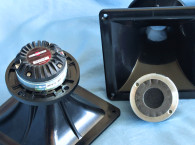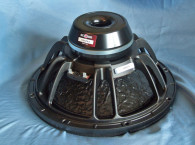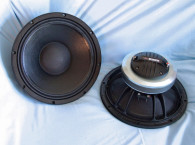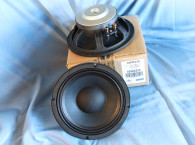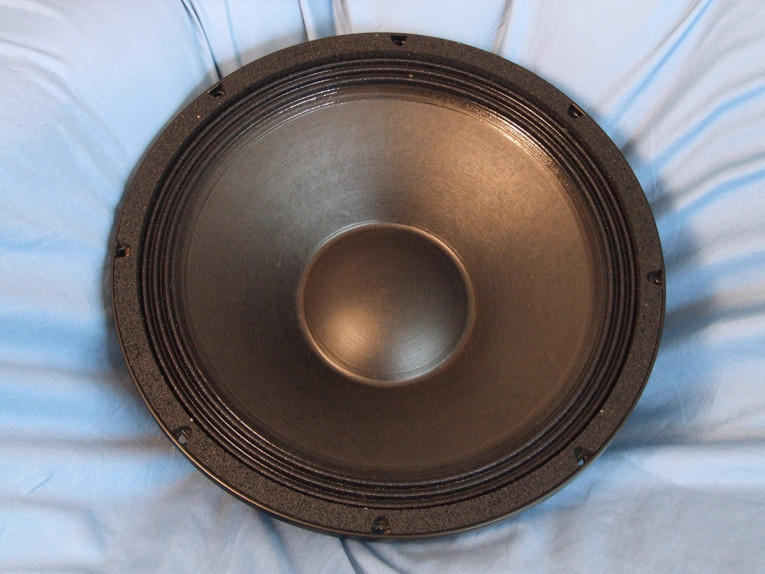


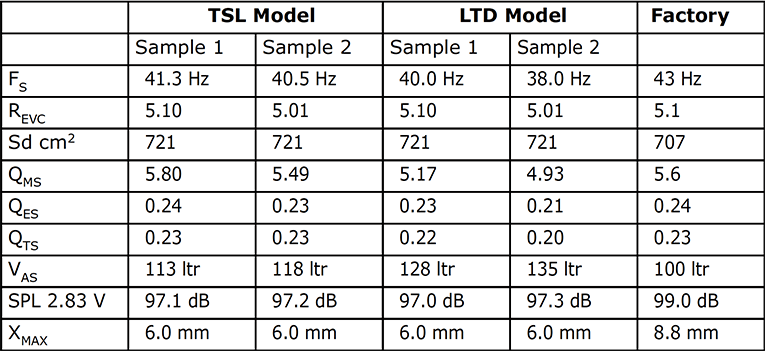
Features for the 14NA100-8 are rather substantial. Starting with the frame, the 14NA100-08 uses a proprietary 12-spoke (six twin spokes) cast-aluminum frame incorporating six 40 mm x 3 mm rectangular vent holes in the area below the spider mounting shelf for enhanced voice coil cooling. This series of cooling vents allows air to move past the voice coil and across the front side of the neodymium motor assembly.
The cone assembly consists of a curvilinear paper cone with a waterproof coating on the front side of the cone along with a 4.5” diameter paper dust cap, likewise with a waterproof coating. Compliance is supplied by a three-roll pleated cloth surround, with the remaining compliance coming from a double silicone 6” diameter flat spider (damper). Tinsel leads are stitched into the spider for longterm stability.
The motor design on the 14NA100-08 utilizes an inside neodymium slug along with a T-shaped pole piece. The neodymium magnet motor was FEA-designed using a 100 mm (4”) diameter voice coil wound with round copper-clad aluminum wire (CCAW) on a non-conducting glass fiber former. Motor parts, the return cup, and the front plate are coated with a black heat-emissive coating for improved cooling, with the cooling additionally enhanced by a 12 mm diameter pole vent and ten 11 mm diameter peripheral vents. Integral to this motor is an aluminum demodulation ring (shorting ring aka Faraday shield) for distortion reduction. Last, the voice coil is terminated to an injection-molded terminal block with standard solderable terminals.


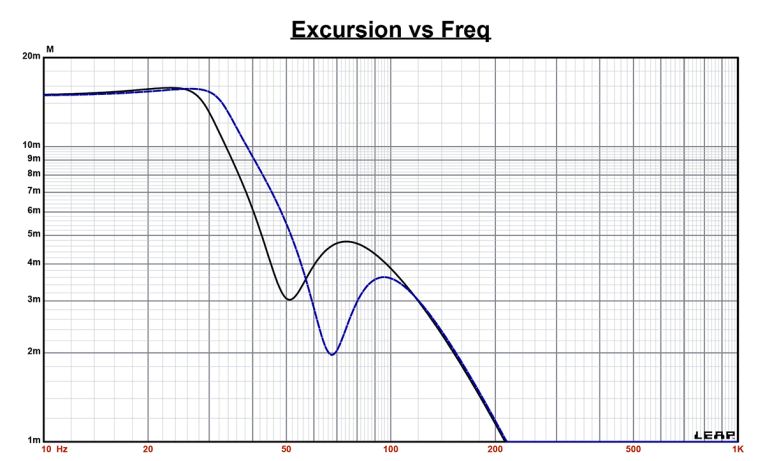
I used the LinearX LMS analyzer and VIBox to create both voltage and admittance (current) curves with the driver clamped to a rigid test fixture in free-air at 0.3 V, 1 V, 3 V, 6 V, 10 V, 15 V, 20 V, and 30 V, allowing the voice coil to progressively heat up between sweeps. The 14NA100-08 remained sufficiently linear enough for LEAP 5 to curve fit at 30 V level, and probably would have stayed linear up to at least 40 V in free-air.
Following my established protocol, I used the physically measured Mmd data (85.69 g for the 14NA100-08). I post-processed the sixteen 550-point stepped sine wave sweeps for each 14NA100-08 sample and divided the voltage curves by the current curves to generate impedance curves, and derived the phase using the LMS calculation method.
I imported the data, along with the accompanying voltage curves, to the LEAP 5 Enclosure Shop software. Because the T-S parameters provided by the majority of OEM manufacturers is generated using either the standard model or the LEAP 4 TSL model, I additionally created a LEAP 4 TSL parameter set using the 1 V free-air curves. I selected the complete data set, the multiple voltage impedance curves for the LTD model, and the 1 V impedance curve for the TSL model in the Transducer Model Derivation menu in LEAP 5 and created the parameters for the computer box simulations.
Figure 1 shows the 1 V free-air impedance curve. Table 1 compares the LEAP 5 LTD and TSL data and factory parameters for both the 14NA100-08 samples. LEAP 5 parameter calculation results for the 14NA100-08 were in close agreement with the published factory data, with a couple of minor exceptions. The first is that my Sd calculations include half the surround while B&C Speakers’ Sd was slightly less conservative. Also the published coil length and gap height dictate a 6 mm Xmax, however, the B&C Speakers’ 8.8 mm Xmax number is accounting for fringe field effects, similar to the Xmax + 15% figure that I use, but more like Xmax +47% and it is based on distortion output, not physical configuration.
Following my established measurement protocol, I configured computer enclosure simulations using the LEAP LTD parameters for Sample 1. I programmed two computer box simulations into LEAP 5: one with the factory recommended vented box with a 2.12 ft3 volume (15% fill material) tuned to 50 Hz, and an Extended Bass Shelf (EBS) vented alignment with a 1.5 ft3 volume tuned to 67 Hz, also simulated with 15% fiberglass damping material. Note the factory enclosure is also an EBS alignment.
Figure 2 displays the SPL results for the 14NA100-08 in the two vented enclosures at 2.83 V and at a voltage level sufficiently high enough to increase cone excursion to Xmax + 15% (6.9 mm for the 14NA100-08). This produced a F3 frequency of 47.1 Hz (F6 = 42 Hz) for the factory recommended enclosure and –3 dB = 65 Hz (F6 = 57 Hz) for the smaller EBS vented simulation. Increasing the voltage input to the simulations until the maximum linear cone excursion limit (6.9 mm by my criteria) was reached resulted in 122.5 dB at 60 V for the factory recommended box and 124 dB for a 60 V input level for the smaller vented box. Figure 3 shows the 2.83 V group delay curves. Figure 4 show the 60 V excursion curves. Please note that the drivers start over excursing below 50 Hz, so an appropriate high-pass filter will increase the undistorted output considerably.


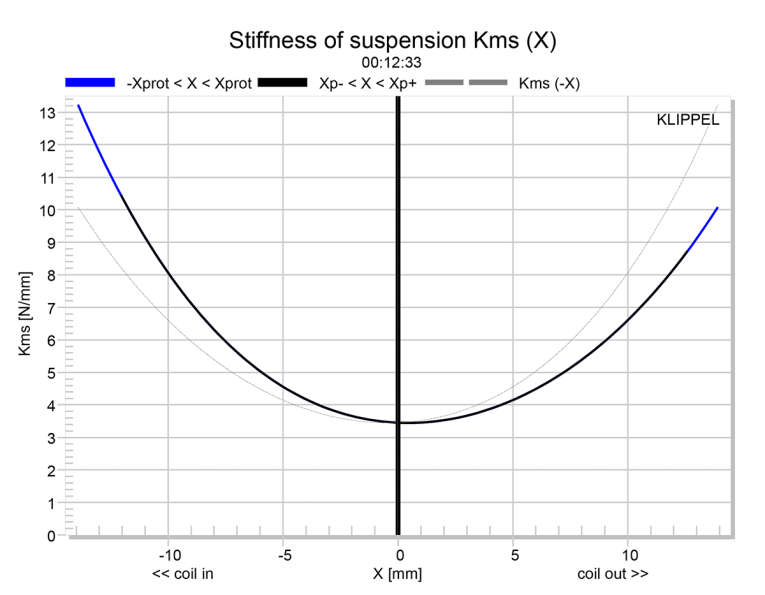
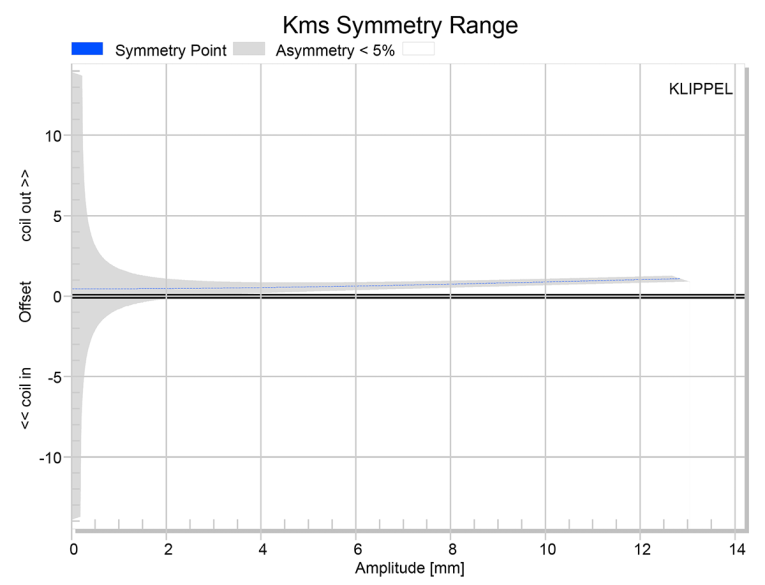
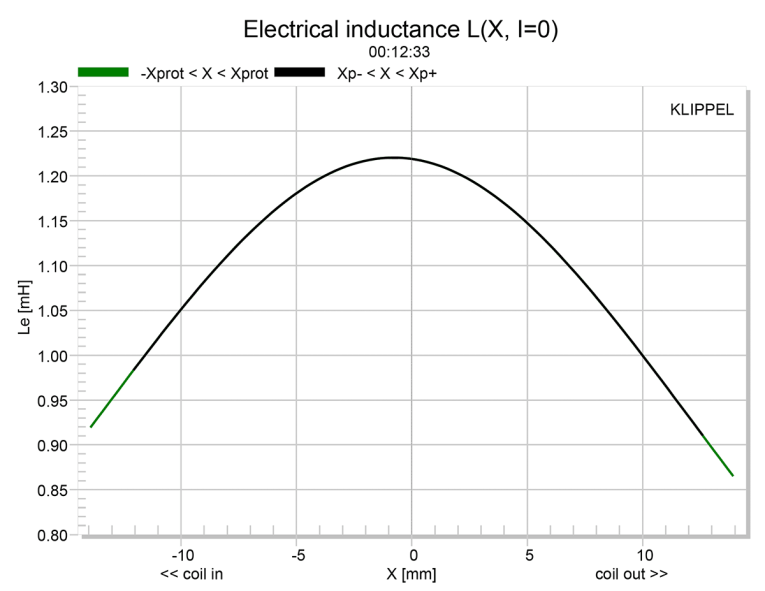
Klippel analysis for the 14NA100-08 —performed by Pat Turnmire, of Redrock Acoustics (author of the SpeaD and RevSpeaD transducer development software) — produced the Bl(X), Kms(X), and Bl and Kms symmetry range plots shown in Figures 5-8. Again, please note that I am displaying the Kms symmetry range plot, which has been discontinued by Klippel GmbH, as we had not yet updated to the current iteration of the Klippel analyzer software.
The Bl(X) curve for the 14NA100-08 (see Figure 5) is moderately broad with some obvious offset, including being somewhat tilted. Looking at the Bl symmetry plot (see Figure 6), this curve shows a 1 mm coil-out offset at 6 mm physical Xmax position. The offset set remains constant throughout the excursion range suggesting a small rearward (coil-in) of the voice coil in the gap.
Figure 7 and Figure 8 show the Kms(X) and Kms symmetry range curves. The Kms(X) curve is also rather symmetrical in both directions accompanied by a very small amount of coil-out offset. Looking at the Kms symmetry range plot, the coil-out offset at the physical 6 mm physical Xmax of the driver is only 0.35 mm.
Displacement limiting numbers calculated by the Klippel analyzer were XBl at 82% Bl = 5.8 mm and for XC at 75% Cms minimum was greater than 5.1 mm, which means that for this B&C Speakers driver, the compliance is the most limiting factor for prescribed distortion level of 10%. If you apply the less conservative 20% criteria, XBl goes to 7.5 mm and the XC to 8.7, so definitely better.
Figure 9 shows the inductance curves Le(X). Inductance will typically increase in the rear direction from the zero rest position as the voice coil covers more pole area, which is not what is happening here, but is typical of this type of neodymium motor that incorporates an aluminum demodulation (shorting) ring. The inductance swing for this driver is a reasonably low 0.18 mH maximum, which is excellent performance for this powerful a neodymium motor.
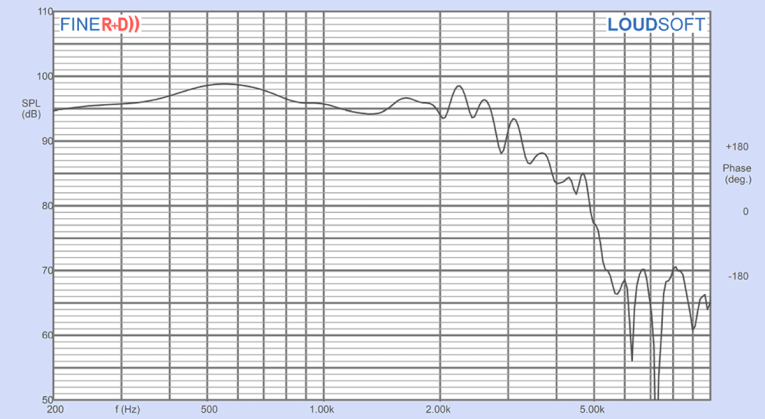

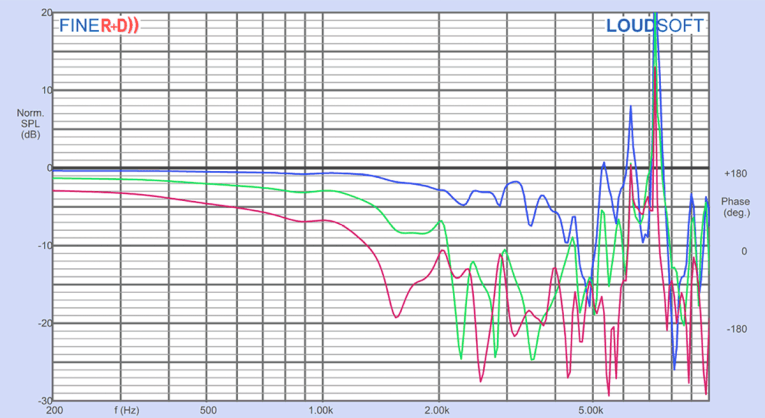
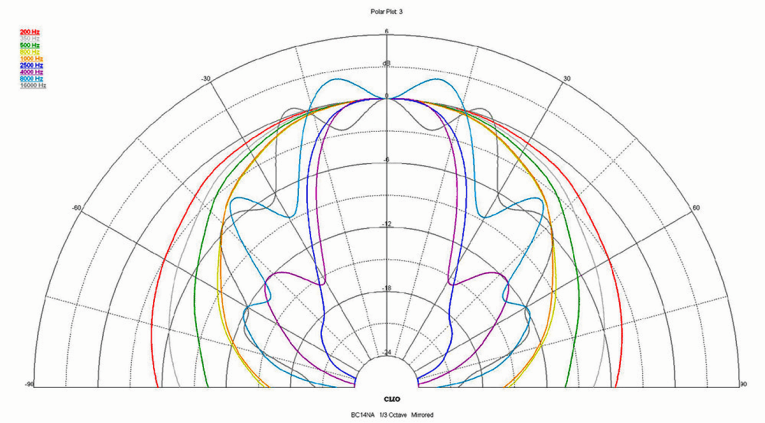

With the Klippel testing complete, I mounted the 14NA100-08 in a foam-filled enclosure that had a 15” × 15” baffle and then measured the DUT using the Loudsoft FINE R+D analyzer and the GRAS 46BE microphone (courtesy of Loudsoft and GRAS Sound & Vibration) both on and off axis from 200 Hz to 20 kHz at 2/0.5 m normalized to 2.83 V/1 m, using the cosine windowed FFT method. Figure 10 gives the 14NA100-08’s on-axis response indicating a smoothly rising response to that is ±2.5dB from 200 Hz to 2 kHz, with no serious break up modes as part of the low-pass roll-off. Figure 11 displays the on- and off-axis frequency response at 0°, 15°, 30°, and 45°, showing the typical directivity for a 14” to 15” woofer. The -3 dB at 30° off-axis with respect to the on-axis response occurs at 1 kHz, a likely upper limit for a crossover is maintaining a descent power response is the goal.
Figure 12 shows the normalized version of Figure 11. Figure 13 shows the CLIO polar plot (in 10° increments and 1/3 octave smoothing). And finally, Figure 14 displays the two-sample SPL comparisons for the 14NA100-08, showing a close match within ±1 dB throughout the operating range to 2 kHz.
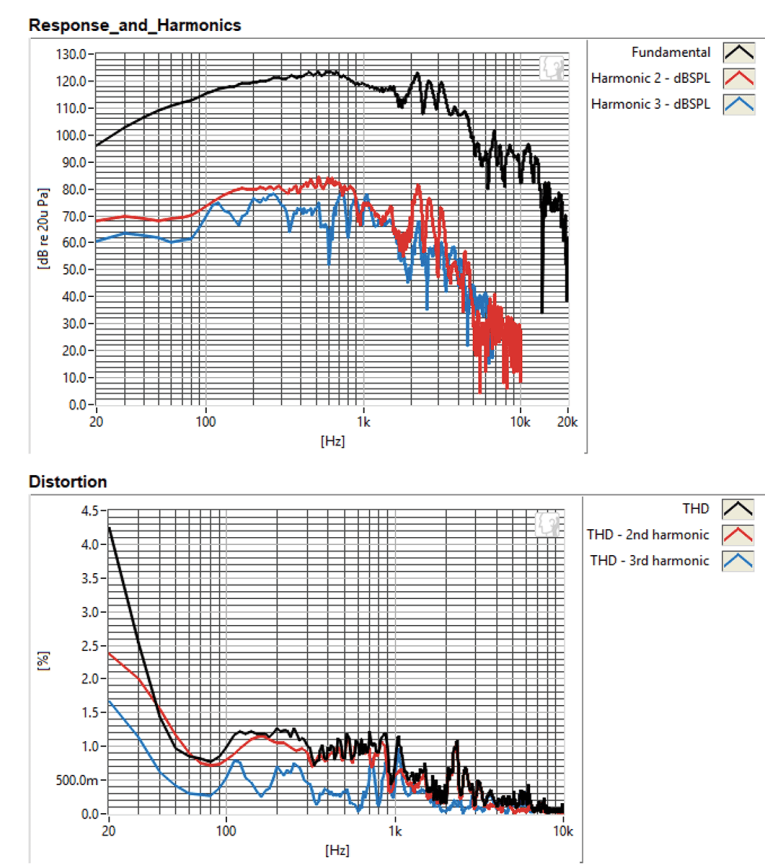
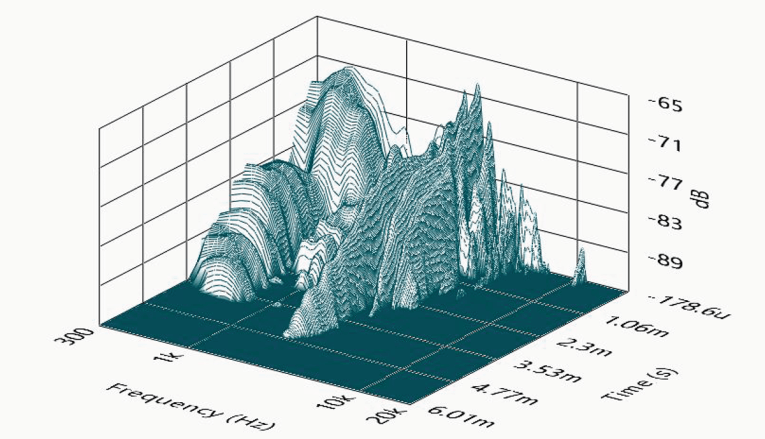

Next, I again employed the Listen, Inc. SoundCheck AudioConnect analyzer and SCM microphone to measure distortion and generate time-frequency plots. For the distortion measurement, I mounted the 14NA100-08 rigidly in free-air, and set the SPL to 104 dB at 1 m (3.86 V) using a pink noise stimulus. Then, I measured the distortion with the Listen microphone placed 10 cm from the driver. This produced the distortion curves shown in Figure 15. I then used SoundCheck to get a 2.83 V/1 m impulse response for this driver and imported the data into Listen’s SoundMap Time/Frequency software. Figure 16 shows the resulting CSD waterfall plot. Figure 17 shows the Wigner-Ville plot.
Looking at the objective data, the14NA100, like all the transducers from B&C Speakers that have been examined in Test Bench, looks to be a very well-crafted driver with a good set of performance trade-offs.
For more information, visit www.bcspeakers.com. VC
This article was originally published in Voice Coil, April 2019.




